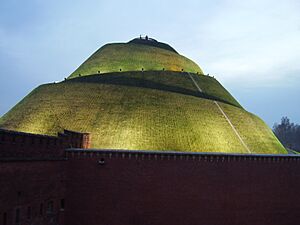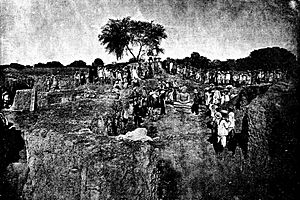Mound facts for kids
A mound is a large pile of earth, sand, rocks, or other materials. Think of it like a small hill that looks like it was made by people. Mounds can be found all over the world.
People have built mounds for many different reasons throughout history. Some were homes, like the ancient "tells" and "terps." Others were used for special ceremonies, as burial places for the dead, or to remember important events and people.
Contents
Mounds in Archaeology
Ancient Mounds of North America
In places like the United States and Canada, an archaeological mound is a special structure built by ancient people. These are usually made of earth. In other parts of the world, like Europe and Asia, similar artificial hills are often called "tumuli" (too-myoo-lee), especially if they are burial sites.
Most mounds in the United States were built long before Christopher Columbus arrived. They were created by Native American peoples. These ancient builders made many different kinds of mounds. Some were flat-topped pyramids or cones, called platform mounds. Others were round cones, or long, loaf-shaped ridges.
Some mounds were even shaped like animals! These are called effigy mounds. You can often see their shapes clearly from above. A few mounds, especially in Wisconsin, even have rock formations, called petroforms, inside or near them.
While many people know about burial mounds, Native American mounds had many other uses too. For example, the Adena culture often used mounds for burials. But other groups used them for different sacred ceremonies or even for everyday activities.
The platform mounds built by the Mississippian culture were very important. They might have held temples, homes for chiefs, or meeting places for councils. They could also have been platforms for public speeches. Other mounds were part of defensive walls, protecting a certain area. The Hopewell culture used mounds to mark special places related to the stars and their ceremonies.
These mounds and other earthworks are the most important large structures built by ancient people in Eastern and Central North America.
Mounds in India
Kankali Tila Mound
Kankali Tila is a famous mound in Mathura, Uttar Pradesh, India. In 1890-91, archaeologists found an ancient Jain temple (called a stupa) here.
Mounds Around the World
While "mound" is a common word, archaeologists often use more specific local names for similar structures in other parts of the world. Each of these terms has its own special meaning.
Types of Mounds
Here are some different types of mounds you might hear about:
- Cairn: A mound made of piled stones.
- Chambered cairn: A stone mound with a room or passage inside.
- Effigy mound: A mound shaped like an animal, person, or symbol.
- Kofun: Large ancient burial mounds found in Japan.
- Platform mound: A flat-topped mound, often used for buildings or ceremonies.
- Subglacial mound: A mound formed under a glacier.
- Tell: An archaeological mound formed by many layers of human settlement over time, common in the Middle East.
- Terp: An artificial dwelling mound built in wetlands, like flood plains, in Europe.
- Tumulus: A general term for an ancient burial mound, also called a barrow.
- Bank barrow: A very long, narrow burial mound.
- Bell barrow: A round burial mound with a ditch around its base.
- Bowl barrow: A simple, bowl-shaped burial mound.
- Chambered long barrow: A long burial mound with internal chambers.
- Kurgan: A type of burial mound found in Eastern Europe and Central Asia.
- Long barrow: A long, rectangular burial mound.
- Oval barrow: An oval-shaped burial mound.
See also
 In Spanish: Montículo para niños
In Spanish: Montículo para niños





